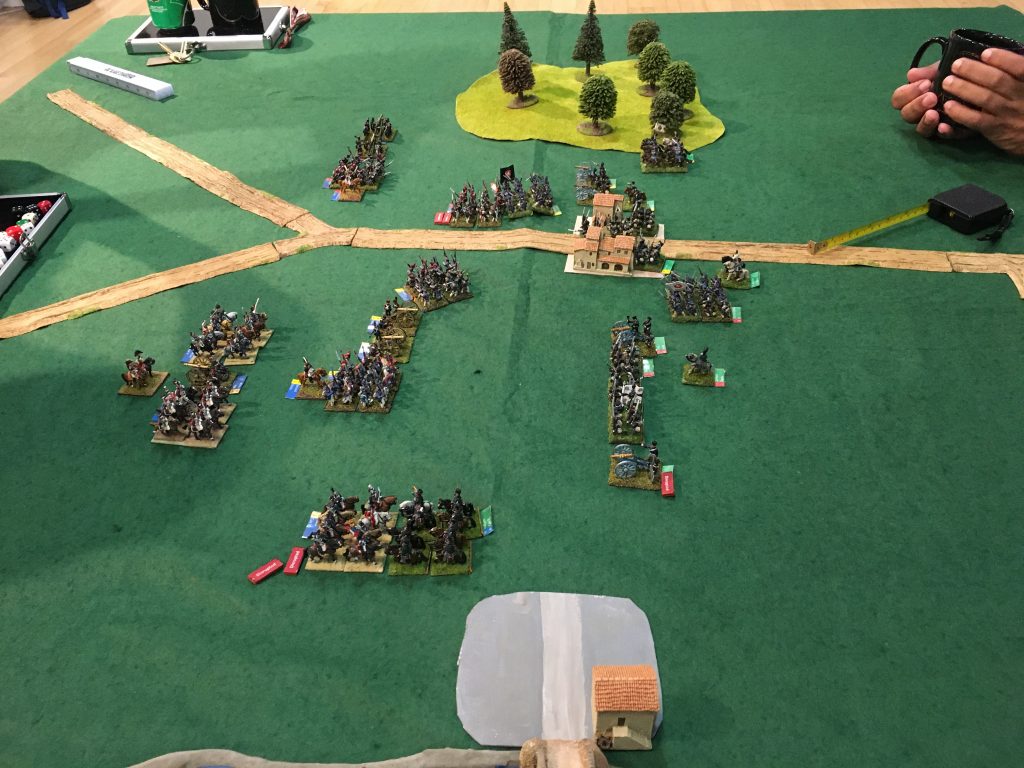
A couple of weeks ago I reported I had taken the radical step of creating a set of standalone Napoleonic rules, based on our house rules for Bloody Big Battles. For the time being I have christened these rules as Big Napoleonic Battles, until I can think of something better. At our club game this week we used the next iteration of these rules. And the verdict from my club colleagues is that they are nearly there. After the next series of tweaks I will post a copy here.
The scenario was one I put together in a hurry, and wasn’t helped by being caught in a horrendous traffic jam on the South Circular on the way. With five players (including one brand new one), each with two or three units plus artillery, we completed five moves, which was the limit I placed on the scenario. I am understanding how to design games that can be completed comfortably on a club evening, where we are limited to two and a half hours. The multiplayer aspect doesn’t speed things up as much as it might, since there is still a tendency for players on the same side to wait for each other. It also helped that I limited unit size to four bases. I hope that can I increase to four units per player, so that we can get bigger games, but the five move limit feels right. It is meant to represent 5 hours of real time, which in 1815 was the length of both Ligny and Quatre Bras – as well as the Prussian involvement in Waterloo.
Now that I have a game that my colleagues like, I am going to put my Napoleonic rule-writing on hold. Doubtless I will want to make small tweaks to BNB, or write some special rules to cover particular situations, such as strongholds (i.e. farmhouses, churches, etc turned into defensive structures). Perhaps extra rules on generals would add appeal. But my more ambitious thoughts on a new turn and movement mechanism will wait. I will switch my rule-writing to another era: WW2 probably.
The scenario had two Prussian corps, each one regular infantry, one landwehr and one cavalry unit and two artillery bases, defending a town, in a position with flanks anchored by a river and village on one side and a dense wood on the other. Attacking them where two French corps, each with two infantry units and two artillery bases, one with a cavalry unit. In addition there was a reserve cavalry corps with one unit of cuirassiers and one of dragoons, both classed as veteran (all other French were trained) and the cuirassiers classed as aggressive. The objective was to take the town in five moves.
The Prussians took a bit of a battering but held out pretty well. The town changed hands several times. I was a bit worried that French cavalry superiority would dominate, and indeed gave the Prussians their second cavalry unit at the last minute in order balance things better. But the cuirassiers performed poorly, in spite of having a +2 advantage on close combat. The Prussian artillery kept stopping them, and they threw badly in combat. The extra Prussian cavalry unit, on the other flank, contributed very little except as an artillery target.
The main rule feature on trial were rules on town combat. Each town block can only be occupied by a single infantry unit (and only attackable by one infantry unit at a time), and any loss on close combat would result in the attacker capturing it. The town provided good cover against fire, but only -1 in close combat. Though some details need to be tweaked, this worked very well. It changed hands on most attacks, with the attackers only to be turned out by an immediate counterattack. This is pretty realistic – historically this would only be complicated by the presence of a strongpoint. But rules to cater for such things would not be simple, and I am leaving it until later.
I have still have questions over the treatment of elite formations. The +2 for the cuirassiers looked a bit rich. That isn’t a problem with the rules as much as one of scenario design. In fact the indifferent performance of that unit showed that I may be worrying too much.
Which leads to the observation that there’s no getting away from the fact that these rules are very dice-heavy, even though they don’t take the fistful of dice approach (you never throw more than two at a time). The same scenario is likely to play very differently if repeated. Personally I don’t mind this: historians are too quick to suggest that historical outcomes are inevitable. Surprising events often happened. But tastes vary. Some of my colleagues loved it when their cunning plan failed because they threw a double one; others were frustrated when a blast on canister fire completely failed to register.
The game went so well that my friends asked for another game next week. I can’t ask for a stronger endorsement that that!
Looks interesting. May join a game if you have a space
Of course Des. Next game is Monday. If you are already fixed can easily arrange a later date.
Matthew